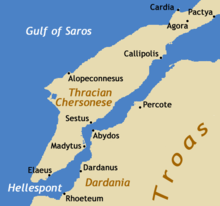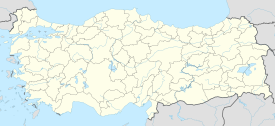Elaeus
This article has been translated from the article Elaious in the German Wikipedia, and requires proofreading. |
Ἐλεοῦς | |
 Elaeus and the Hellespont | |
| Location | Seddülbahir, Çanakkale Province, Turkey |
|---|---|
| Region | Thracian Chersonese |
| Type | Settlement |
| History | |
| Builder | Colonists from Teos |
Elaeus (Ancient Greek: Ἐλαιοῦς Elaious, later Ἐλεοῦς Elaeus), the “Olive City”, was an ancient Greek city located in Thrace, on the Thracian Chersonese. Elaeus was located at the southern end of the Hellespont (now the Dardanelles) near the southernmost point of the Thracian Chersonese (now the Gallipoli peninsula) in modern-day Turkey. According to the geographer Scymnus, Elaeus was founded by settlers from Ionian Teos.
History

The most important cities of the Chersonese were Lysimachia, Pactya, Gelibolu, Alopeconnesus, Sestos, Madytos and Elaeus. The peninsula was renowned for its wheat. It also profited from its strategic location on the main trade route between Europe and Asia, as well as the possibility of controlling shipping to Crimea. For these reasons, Elaeus later received colonists from Athens, who built fortifications there.
The last resting place of the mythological hero Protesilaus was said to be at Elaeus, near a steep coastal cliff. According to Homer’s Iliad,[1] Protesilaus was the first Greek to set foot on land during the Trojan War, for which - according to the will of the gods - he was also the first to die. His tomb at Elaeus lay on the European coast opposite Troy, and became a destination for pilgrimages by members of the cult of Protesilaus. Later, the temple housed votive offerings, and was surrounded by a settlement. In antiquity, the location was variously under Athenian, Persian, Spartan and later Macedonian control.
During the second Persian invasion of Greece (480 - 479 BCE), the Persian headquarters was temporarily located at Elaeus.[2] Under Persian occupation, the governor Artayctes desecrated the sacred grove of Protesilaus.[3] For this, he was captured and crucified in 479 BCE by the Athenian general Xanthippos, the father of Pericles. Elaeus belonged to the Delian League, and from 375 BCE to the Second Athenian Empire.
A stele dating from the year 340 BCE, at which time Elaeus was governed by Athens, contains an inscription in Ionian script.[4] The stele proclaimed that the Athenians gave certain privileges, such as political rights and ownership of property, to the people of Elaeus, and that the Athenian general Chares was charged with watching over them.
Alexander the Great is said to have visited Elaeus at the start of his Persian campaign in the spring of 334 BCE, in order to visit the temple of Protesilaus. Here he made an offering, before crossing the Dardanelles, and himself becoming the first of his army to set foot in Asia.
Imperial coins were struck at Elaeus in the time of the Roman emperor Commodus, of which a few remain. They depict Protesilaus as a warrior standing on the bow of a ship, ready to be the first to spring onto the enemy shore.[5]
During the First World War, French and British troops temporarily occupied Cape Helles and Morto Bay. French soldiers plundered the region of ancient Elaeus. The French army brought five sarcophagi, jewellery, ancient pottery and other objects to Paris, which are now displayed in the Louvre. The area around Elaeus was subsequently destroyed by the intense fighting and artillery bombardments.
See also
References
- ^ Homer, Iliad, Line 695, vol. 2
{{citation}}: External link in|series= - ^ Herodotus, Histories, vol. 7, pp. 22–24
- ^ Smith, William (1854), "Elaeus", Dictionary of Greek and Roman Geography
{{citation}}: External link in|chapter= - ^ Inscriptiones Graecae II², 228, Retrieved on 4 January 2013.
- ^ Ancient coinage of Thrace, Retrieved on 4 January 2013.
Sources
- Pseudo-Scymnus, Periodos to Nicomedes ("Periegesis"), Line 707 (in Ancient Greek)
{{citation}}: External link in|series= - Procopius, "Ch. 10", Buildings of Justinian, Lines 3 and 26, vol. 4
{{citation}}: External link in|series= - Herodotus, Histories, vol. 7, pp. 22–24 and 33
- Arrian, "11. Alexander Crosses the Hellespont and Visits Troy", The Campaigns of Alexander, vol. 1
{{citation}}: External link in|chapter= - Hansen, M. H.; Nielsen, T. H.; et al. (2005), "Thracian Chersonesos", An Inventory of Archaic and Classical Poleis, Oxford University Press
- Freely, John (2004), The Western Shores of Turkey, Tauris Parke Paperbacks, p. 19
- Harding, Philipp (1985), "Section 94", From the End of the Peloponnesian War to the Battle of Ipsus, Cambridge University Press, p. 118
- Danoff, Christo M. (1967), Elaius, Der Kleine Pauly (KlP) (in German), vol. 2, Stuttgart, pp. 231–232
{{citation}}: CS1 maint: location missing publisher (link) - Instinsky, H. U. (1949), Alexander der Große am Hellespont (in German), Bad Godesberg: Helmut Küpper Verlag
- Choiseul-Gouffier (1842), Voyage pittoresque dans l’Empire Ottoman (in French), vol. 3 (2nd ed.), Paris, p. 373f

